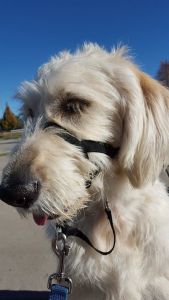These past few months, my dog trainer has been searching for a prospective SD candidate to begin training for me. My vote was for a standard poodle or a golden retriever, two rather intelligent breeds known for success as service dogs.
On September 12, 2015 my trainer asked me whether I would consider a poodle mix, saying that she may have an “already started” older puppy available to her.
She began to list things she knew about this dog, including that basic obedience is already done. In fact, he’d been in training to be a service dog, and was trained by someone very good! Happily for me, but unfortunately for the disabled person, they would up to be allergic to the dog.
Half Labrador, a quarter golden retriever, and a quarter standard poodle does not generally create a hypoallergenic dog, contrary to popular belief. Many people think that poodle mixes, just like standard poodles, are hypoallergenic. This is a common belief, but it’s false. Just like any mutt, a poodle mix may have traits of either parent, including the aspects that people are allergic to. In the case of this dog, he produces allergens that someone with a dog allergy couldn’t handle.
At eleven months old, he is past the fear stages of a puppy. “Barring something extremely traumatic happening, the dog is out of the failure stage,” my trainer told me. It’s that first year of life when a dog would generally react poorly to a situation or stimulus, if there was going to be a reaction at all. But this dog has already had all of his socialization to different people, animals, sounds, environments, textures to walk on, etc, and passed! The foundations have been laid for a very high chance of success here, even better odds than if we were starting with an eight-week-old puppy. With a young puppy, training would begin and continue for a year while I waited and desperately hoped that nothing happened to “wash out” or fail the dog from his or her training. With this dog, thankfully, we’re past that point. This boy is well on the path to becoming a service dog.
Was I interested in this dog? My response, of course, was that the only reason I wouldn’t want him would be if his coat was rough or wiry!
More information came on September 15th.
He’d come from Craigslist, picked out by the person for whom he’d been intended, and brought home at eight weeks old. Training started at the age of nine weeks. Usually dogs advertised on Craigslist don’t come from the best breeders, and their heritage is murky at best. His, though, isn’t a complete guess: we know what his parents were, just not their colors. With one canine parent being a full Labrador retriever, and the other parent being half poodle/half golden retriever, he’s what’s called a “doodle”. (Doodles are mutts, poodle mixes advertized as a “designer” “breed” and sold for exorbitant prices to people who don’t know any better. Often they are poorly behaved and unhealthy.) He looks like a scruffy yellow Lab, so I’m guessing that his Lab parent was a yellow Lab, and his poodle/golden mix parent came from a white poodle grandparent. But that will remain a mystery.
The sire of this dog –whether that’s the purebred Lab or the poodle/golden mix is anyone’s guess– had his hips tested and they were found to be sound. That’s encouraging for his own hips being fit for life as a working dog. Already he’s around fifty-five pounds, and estimated to mature in the range of sixty to sixty-five pounds as an adult. The exact size of dog I’d hoped to be matched to, if I could pick their size.
Beyond all of the basic obedience and socialization, he has been trained to retrieve dropped items, which is a task on my list, one I’ll need in case my back goes bad again. Currently he is working on “under”, tucking himself under a table or similar object to be unobtrusive, as well as learning to ignore distracting people and dropped food.
According to the original trainer, he’s a very soft and attentive dog. In this situation, “soft” does not refer to his coat. In the dog training world, a soft dog is one who doesn’t need much correction. They might even be called sensitive, in some ways. We were also told that he would make a great service dog for my specific needs and disability.
October 4th was the day that my trainer went to meet this candidate for the first time to formally assess him.
This included putting him through his paces, and seeing what needs work. How well can he figure out body language? Does he take cues from the handler well? What’s his startle response like? Even more importantly, what’s his response when he’s purposely pushed to the point of stress?
My trainer purposefully created stress by incorporating several overwhelming noises and experiences, she said. Dogs barking, kids jumping and screaming and running past him, and loud noises all at once. In response to this, he showed a couple of very minor signs (yawning, licking his lips, and shaking off) but was easily redirected to the handler. Only once did he show this stress, and he also recovered quickly, which is what we would hope for.
What I wanted to know was how this guy handled anxiety. It’s an issue I deal with, and it’s very possible for a dog to pick up on a human’s anxiety, something that can ruin them for service dog work. (The last thing you want is a dog who becomes anxious in public if the handler is anxious, or worse yet, protective!) Of course, since I wasn’t there to radiate anxiety myself, my trainer faked some anxiety. The dog noticed and was attentive, but not to the point of being stressed by it or reactive to it. Wonderful!
Like most young dogs this age, he’s still a hyper puppy. When he’s not joyfully running around, he does problem solve well. Some of the things my trainer tested with him were finding a treat hidden under a cup, finding a toy, and figuring out what she wants from her cues and body language. Typically dogs work best for either treats, toys, or praise. For this boy, it’s the reward of treats or toys (play time) that motivate him the most.
It’s guessed that he is around 27 or 28 inches tall, meaning he’s tall and lanky for an adolescent. If he is indeed 27” at the withers, I could just about stand next to him without shoes and lay my hand flat on his back! This is also something I’d secretly hoped for in my future service dog.
I got the wonderful news on November 5th that the dog was ready to go.
And better still, my dog trainer would be going to pick up this dog for me in three short days, very early in the morning on Sunday the 8th! He turns a year old on November 11th, and his birthday will be celebrated in his new home (for the next year, anyway) with my dog trainer. I know that I’ll certainly be celebrating from out here in California.
Say hello to Levi!

